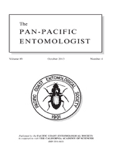
PAN-PACIFIC ENTOMOLOGIST
Scope & Guideline
Celebrating the Vital Roles of Insects in Nature
Introduction
Aims and Scopes
- Taxonomy and Systematics:
The journal publishes papers that describe new species, revisions of existing taxa, and provide taxonomic keys, which are essential for the identification and classification of insects. - Biodiversity and Distribution:
Research on the geographic distribution of insect species, including new records and state or country records, highlights changes in biodiversity and informs conservation efforts. - Ecology and Behavior:
Studies examining the ecological roles of insects, including their interactions with other species and their environment, contribute to a deeper understanding of ecosystem dynamics. - Biological Control and Pest Management:
The journal includes research on the use of insects as biological control agents, discussing their effectiveness and ecological impacts on pest management strategies. - Conservation and Environmental Impact:
Papers that assess the impact of environmental changes on insect populations and advocate for conservation measures are integral to the journal's mission.
Trending and Emerging
- Molecular Taxonomy and Genetics:
There is a growing emphasis on molecular techniques for species identification and phylogenetic studies, indicating a trend towards integrating genetic analysis in traditional taxonomy. - Ecological Interactions and Behavior:
Research focusing on the ecological roles and behaviors of insects, including host-parasite interactions and community dynamics, is increasingly prevalent, reflecting a holistic approach to understanding biodiversity. - Conservation Biology and Habitat Studies:
Papers addressing conservation issues, habitat assessments, and the effects of climate change on insect populations are emerging as critical themes, highlighting the need for sustainable practices. - Regional Biodiversity Assessments:
There is a notable increase in studies that focus on specific regions, such as the Galapagos Islands and southern Mexico, which contribute to targeted conservation strategies and biodiversity documentation. - Public Health and Insect-Vectored Diseases:
Research related to disease vectors and their management is becoming more prominent, reflecting the intersection of entomology with public health concerns.
Declining or Waning
- Historical and Biographical Studies:
Research focusing on historical accounts and biographies of entomologists, though important, has become less frequent as the journal emphasizes empirical research and contemporary issues in entomology. - Generalized Surveys:
Broad surveys of insect populations without specific ecological or taxonomic focus are appearing less frequently, as more targeted studies with in-depth analysis are prioritized. - Invasive Species Documentation:
While still relevant, the frequency of papers solely dedicated to documenting invasive species has decreased, possibly due to a shift towards understanding ecological impacts and management strategies.
Similar Journals
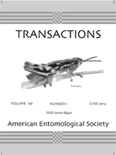
TRANSACTIONS OF THE AMERICAN ENTOMOLOGICAL SOCIETY
Charting the Course for Future Entomological Discoveries.TRANSACTIONS OF THE AMERICAN ENTOMOLOGICAL SOCIETY, published by the American Entomological Society, is a distinguished journal committed to advancing the field of entomology through innovative research and comprehensive reviews. With an ISSN of 0002-8320 and an E-ISSN of 2162-3139, this journal has been a vital resource for entomologists since its inception, showcasing significant findings in insect science as well as ecology, evolution, behavior, and systematics. Although currently not offering Open Access, the journal remains a pivotal platform for professionals, researchers, and students interested in the biological sciences related to insects. The journal's influence is reflected in its Scopus rankings, with a Q3 designation in Insect Science and a Q4 designation in Ecology, Evolution, Behavior and Systematics as of 2023. With a convergence of published years from 1993 to present, TRANSACTIONS aims to foster a deep understanding of insect-related topics, thereby contributing valuable insights that may influence both academic and practical realms within entomology.

FRAGMENTA ENTOMOLOGICA
Advancing knowledge in entomology and ecology.FRAGMENTA ENTOMOLOGICA is a prominent peer-reviewed academic journal published by UNIV DEGLI STUDI DI ROMA LA SAPIENZA, focusing on various dimensions of entomology and insect science. With an ISSN of 0429-288X and an E-ISSN of 2284-4880, this journal has embraced an Open Access model since 2006, ensuring that valuable research is widely accessible to the global scientific community. Based in Italy, at the DIPARTIMENTO DI BIOLOGIA ANIMALE E DELL'UOMO in Rome, FRAGMENTA ENTOMOLOGICA is recognized for its commitment to high-quality research, ranking in the Q3 category across multiple categories, including Ecology and Insect Science, in 2023. Its Scopus rankings further underscore its relevance, showcasing its role in advancing knowledge in the fields of Ecology, Evolution, and Insect Behavior. This journal serves as an essential resource for researchers, professionals, and students interested in the intricate world of insects and their ecological roles, fostering academic discourse that bridges theoretical and practical entomological studies.

Austral Entomology
Advancing Knowledge in Insect Ecology and AgronomyAustral Entomology, published by Wiley, is a leading journal in the field of entomology, specializing in the study of insects within the wider context of agronomy, ecology, and evolutionary biology. With an impact factor that reflects its growing influence and a commendable H-Index, this journal serves a vital role in disseminating cutting-edge research that bridges the gap between basic entomological studies and applied agricultural practices. Since its inception in 2014, Austral Entomology has maintained a strong commitment to open access, fostering a collaborative environment for researchers and practitioners. Recognized within category quartiles Q2 across multiple fields such as Agronomy and Crop Science and Ecology, it ranks impressively among journals in Insect Science, showcasing the significance of its contributions to understanding insect behavior, ecology, and systematics. Given its robust accessibility options, the journal not only enhances the visibility of entomological research but also empowers professionals and students alike to engage with and apply findings in real-world contexts.
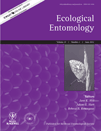
ECOLOGICAL ENTOMOLOGY
Pioneering Research on Insect-Environment DynamicsECOLOGICAL ENTOMOLOGY is a leading peer-reviewed journal published by Wiley, focusing on the dynamic interplay between insects and their environments. With an ISSN of 0307-6946 and an E-ISSN of 1365-2311, this journal has been a pivotal resource in the fields of ecology and insect science since its inception in 1976, and is set to continue until 2024. Recognized for its high academic standards, the journal maintains a prestigious Q1 ranking in both the Ecology and Insect Science categories for 2023, and ranks in the 84th percentile among its peers in agricultural and biological sciences. Although not an Open Access journal, it provides vital insights into ecological processes and insect interactions, making it an essential read for researchers, professionals, and students committed to understanding and conserving biodiversity. The contributions published within its pages significantly advance the knowledge of ecological systems and inform practical approaches to environmental management.
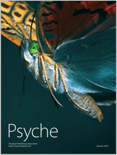
Psyche-A Journal of Entomology
Unveiling the Secrets of Insect EcosystemsPsyche-A Journal of Entomology is a distinguished open-access journal published by Hindawi Ltd, specializing in the field of entomology, including aspects of ecology, evolution, behavior, and systematics of insects. Established in 1874, this journal has a rich history of contributing to the scientific community by disseminating high-quality research related to insects and their diverse interactions within ecosystems. With an impact factor placing it in Q3 for both Ecology, Evolution, Behavior and Systematics and Insect Science, Psyche serves as a pivotal platform for researchers, professionals, and students aiming to deepen their understanding of insect-related science. The journal's commitment to open access ensures that research is accessible to a global audience, promoting collaboration and innovation in entomological studies. Covering a broad timeline of converged years from 1874 to 2024, Psyche fosters a comprehensive dialogue around insect biodiversity, conservation, and the ever-evolving dynamics of ecosystems in which insects play crucial roles.

CANADIAN ENTOMOLOGIST
Cultivating a Deeper Understanding of Insect InteractionsCanadian Entomologist, published by Cambridge University Press, is a prominent journal dedicated to the field of entomology, covering key areas such as insect science, ecology, and evolutionary biology. With its origins dating back to 1868, this esteemed journal has continuously contributed to the understanding of insect behavior, systematics, and physiology, engaging researchers and professionals alike. Although currently not an Open Access journal, it offers valuable insights through its rigorously peer-reviewed articles, reflecting its commitment to scientific excellence. The journal has garnered a respectable Q3 ranking in various categories, including Ecology, Evolution, Behavior, and Systematics, making it a critical resource for scholars and students who seek to explore the complex interactions within insect populations and their environments. Researchers can trust Canadian Entomologist to provide relevant and impactful research that shapes contemporary understanding in the realm of entomological studies, fostering the growth of this vital scientific discipline.
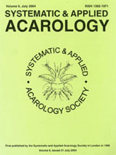
SYSTEMATIC AND APPLIED ACAROLOGY
Advancing acarology through innovative research.Systematic and Applied Acarology, with ISSN 1362-1971 and E-ISSN 2056-6069, is a leading international journal published by the Systematic & Applied Acarology Society in association with the esteemed Natural History Museum, London. This journal offers a vital platform for researchers in the fields of acarology, ecology, insect science, and evolutionary biology, boasting an impressive impact factor reflecting its significance, particularly with a Q1 ranking in Insect Science and Q2 rankings in Ecology and Evolution, Behavior and Systematics. The open access model ensures that groundbreaking research is readily accessible to a global audience, enhancing collaboration and knowledge sharing. With a scope that encompasses innovative studies, systematic methodologies, and applied acarology research, Systematic and Applied Acarology is committed to advancing the understanding of mite and tick biology, ecology, and their interactions within ecosystems. The journal continues to thrive as an essential resource for students, professionals, and researchers keen on pioneering studies in acarology, making impactful contributions to the scientific community.

REVISTA DE LA SOCIEDAD ENTOMOLOGICA ARGENTINA
Bridging Disciplines in the World of InsectsREVISTA DE LA SOCIEDAD ENTOMOLOGICA ARGENTINA is an esteemed open-access journal dedicated to the field of entomology, published by the SOCIEDAD ENTOMOLOGICA ARGENTINA. Since its transition to open access in 2013, the journal has sought to promote research in insect science, ecology, and related disciplines, facilitating global dissemination of knowledge and encouraging collaborative studies across borders. Located in the vibrant scientific landscape of La Plata, Argentina, the journal is indexed in Scopus and categorized in the fourth quartile of ecology and insect science, reflecting its commitment to enhancing the discourse within these critical fields. Aiming to bridge the gap between researchers, students, and professionals, REVISTA DE LA SOCIEDAD ENTOMOLOGICA ARGENTINA serves as a platform for innovative research, reviews, and reports on ecological interactions, behavior, and systematic entomology, ultimately driving forward our understanding of insect biodiversity and its broader environmental impacts.
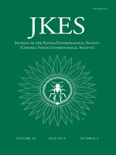
JOURNAL OF THE KANSAS ENTOMOLOGICAL SOCIETY
Bridging Research and Agricultural ImpactJOURNAL OF THE KANSAS ENTOMOLOGICAL SOCIETY, published by the Kansas Entomological Society, serves as a vital platform dedicated to the field of entomology and insect science. With an ISSN of 0022-8567 and an E-ISSN of 1937-2353, this journal has established itself since its inception in 1994, continuing to contribute valuable research up to 2024. Despite its current Q4 categorization in the 2023 Insect Science rankings, it ranks 106 out of 181 in Scopus, representing a significant opportunity for researchers to disseminate their findings in a supportive and engaged community. Although it is not an open-access journal, its commitment to rigorous peer review and relevance in agricultural and biological sciences makes it an essential resource for professionals, scholars, and students alike. The journal's focus on local and regional entomological issues often addresses broader ecological impacts, showcasing the importance of insects in environmental health and agriculture. We invite you to explore the rich tapestry of findings and discussions within this esteemed publication.
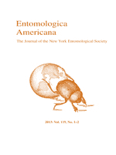
Entomologica Americana
Advancing Knowledge in Insect ScienceEntomologica Americana is a pivotal journal in the field of Insect Science, published by the esteemed New York Entomological Society Inc. With its ISSN (1947-5136) and E-ISSN (1947-5144), this journal serves as a critical resource for researchers, professionals, and students dedicated to the study of entomology. Although it is categorized in the Q4 quartile for Insect Science as per the 2023 Scopus Rankings, where it ranks 179 out of 181, it continues to provide valuable insights into various aspects of insect biology, ecology, and conservation. The journal has been actively publishing since its convergence years from 2009 to 2017, and in selected years thereafter, including 2019, 2021, and 2023. Located at the iconic American Museum of Natural History in New York City, Entomologica Americana is a testament to the ongoing exploration and understanding of the insect world that underpins biodiversity and ecosystem health. Although it does not operate under an Open Access model, it offers a vital platform for scholarly communication and the dissemination of research findings, making it indispensable for anyone involved in or entering the fascinating field of entomology.